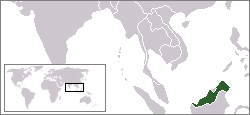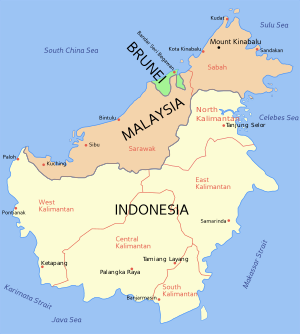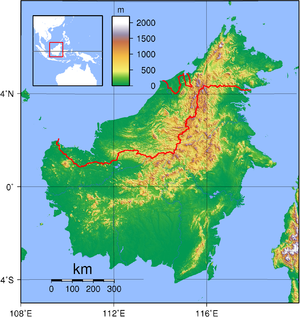شرق ماليزيا
شرق ماليزيا (Malaysia Timur؛ إنگليزية: East Malaysia)، وتُعرف أيضاً بإسم صباح، سرواك ولابوان (Sabah, Sarawak dan Labuan)[1] أو بورنيو الماليزية،[2] هي الجزء من ماليزيا على جزيرة بورنيو، ثالث أكبر جزيرة في العالم. وتضم الولايات الماليزية صباح، الأقرب إلى الفلپين من غرب البلد، وسرواك في الغرب والإقليم الفدرالي لابوان. لابوان هي جزيرة في أرخبيلها الصغير الذي يحمل نفس الاسم إلى الشمال مباشرة من بروناي؛ وأقرب كتلة أرضية له هي صباح.[3] وتقع إلى الشرق من شبه الجزيرة الماليزية (التي تُعرف أيضاً باسم غرب ماليزيا)، وهي الجزء من البلد الواقع في شبه جزيرة الملايو. الجزآن يفصلهما بحر الصين الجنوبي.[4][5]
شرق ماليزيا هو أقل سكاناً وأقل من حيث تطور التجمعات السكنية، بالمقارنة مع غرب ماليزيا. وبينما يضم غرب ماليزيا المدن الكبرى للبلد (كوالا لمپور و پناڠ)، فإن شرق ماليزيا هو الأكبر من حيث المساحة والأكثر من حيث المصادر الطبيعية (خصوصاً احتياطيات النفط والغاز). وبشكل جماعي-إقليمي، فإن وضع "مدينة" حصل عليه القليل من التجمعات السكنية، مثل كوچڠ و كوتا كينابالو و ميري. العديد من التجمعات الهامة الأخرى مصنفة كبلدات، بما في ذلك العديد بتعداد يفوق 100,000 نسمة. ويضم شرق ماليزيا جزءاً معتبراً من الغابات المطيرة بمنخفضات بورنيو و الغابات المطيرة ببورنيو الجبلية المتنوعين حيوياً.
وبشبيه الإنسان أورانج أوتان,
وأيضا يتميز بأنه مصدر البترول حول جزر سبراتلي التي تحاول الصين سرقتها والسيطرة عليها ...
التاريخ
قبل وصول الأوروبين كانت كل المنطقة (جنوب شرق آسيا) عبارة عن سلطنات إسلامية أسلمت طواعية بلا فتح أو غزو,
التقسيم الأول بين الأيبيرين لتكملة حروب التنصير كانت بين الأسبان شرقا والبرتغال غربا,
وجلب غير المسلمين كعمال ومحظيات من الصين والهند,
التقسيم الثاني بين البريطانيين شمالا وهولندا جنوبا,
والتوسع في جلب غير المسلمين كعمال ومحظيات من الصين والهند,
ومع حركات الإستقلال من الإستعمار أرادت إندونيسيا التي كانت وقتها وراء تقليعة الشيوعية الإستحواذ علي كل جزيرة بورنيو,
لكن أهل صباح وسرواك كانو تحت الإحتلال البريطاني ولا قبل لهم بمحاربة إندونيسيا فطلبو الإنضمام لماليزيا الناشئة رغم إنهم أقلية مالايو,
ومرات يظهر من تحدثو عن الاستقلال,
لكن خوفا من ان تضمهم اندونيسيا يفضلو البقاء مع ماليزيا ...
أما سلطان بروناي فرفض ان ينضم لماليزيا بحجة إنهم تقبلو البوذيين والهندوس وأعلن أن بروناي للمسلمين فقط.
Some parts of present-day East Malaysia, especially the coastal regions, were once part of the thalassocracy of the Sultanate of Brunei.[6] However, most parts of the interior region consisted of independent tribal societies.[7]
الجغرافيا الطبيعية
The landscape of East Malaysia is mostly lowland rain forests with areas of mountain rain forest towards the hinterland.
The total area of East Malaysia is 198,447 km2, representing approximately 60% of the total land area of Malaysia and 26.4% of the total area of Borneo, which is 50% bigger than Peninsular Malaysia at 132,156 square kilometres (51,026 sq mi), comparable with South Dakota or Great Britain.
ويضم شرق ماليزيا أعلى خمس جبال في ماليزيا، the highest being Mount Kinabalu at 4095 m, which is also the highest mountain in Borneo and the 10th highest mountain peak in Southeast Asia. It also contains the two longest rivers in Malaysia – Rajang River and Kinabatangan River.[8]
Banggi Island in Sabah and Bruit Island in Sarawak are the two largest islands that are located entirely within Malaysia.[8] أكبر جزيرة هي بورنيو، التي تتقاسمها مع إندونيسيا و بروناي.[9] The second largest island is Sebatik Island, in Sabah, which is shared with Indonesia.[10][11]
Sarawak contains the Mulu Caves within Gunung Mulu National Park. Its Sarawak Chamber is the largest known cave chamber in the world. The Gunung Mulu National Park was declared a UNESCO World Heritage Site in November 2000.[12]
Sabah's attractions include World Heritage Site Kinabalu Park (which includes Mount Kinabalu),[13] and Sipadan Island (a diving and bio-diversity hot-spot).[14]
الجيولوجيا
Several oil and gas fields have been discovered offshore, including the Samarang oil field (1972) offshore Sabah, the Baronia oil field (1967) offshore Sarawak, and the Central Luconia natural gas fields (1968), also offshore Sarawak.[15] The Baronia Field is a domal structural trap between two east–west growth faults, which produces from late Miocene sandstones interbedded with siltstones and clays at 2 km depth in 75 m of water.[15] The Samarang Field produces from late Miocene sandtones in an alternating sequence of sandstones, siltstones and clays in an anticline at a depth of about 3 km in water 9–45 m.[15] The Central Luconia Gas Fields produce from middle to late Miocene carbonate platform and pinnacle reefs from 1.25-3.76 km deep and water depths 60-100m.[15]
السكان
الأعراق في شرق ماليزيا (2015)
The total population of East Malaysia in 2010 was 5.77 million (3.21 million in Sabah, 2.47 million in Sarawak, and 0.09 million in Labuan),[16] which represents 20.4% of the population of Malaysia. A significant part of the population of East Malaysia today reside in towns and cities. The largest city and urban centre is Kuching, which is also the capital of Sarawak and has a population of over 600,000 people. Kota Kinabalu is the second largest, and one of the most important cities in East Malaysia. Kuching, Kota Kinabalu, and Miri are the only three places with city status in East Malaysia. Other important towns include Sandakan and Tawau in Sabah, Sibu and Bintulu in Sarawak, and Victoria in Labuan.
الأمن
The state of Sabah has been subjected to attacks by Moro pirates and militants since the 1960s and intensification in 1985, 2000, 2013. The Eastern Sabah Security Zone (ESSZONE) and Eastern Sabah Security Command (ESSCOM) were established on 25 March 2013 to tighten security in the region. Since 2014, a 12-hour dusk-to-dawn curfew has been imposed on six Sabah east coast districts.[17]
الهامش
- ^ المصطلح الأخير هو الأكثر شيوعاً في ماليزيا لتجنب دلالة "شرق ماليزيا" مقابل "غرب ماليزيا" (شبه الجزيرة الماليزية) كما لو كانتا دولتين منفصلتين، كما كان الحال في ألمانيا الشرقية وألمانيا الغربية.
- ^ "Malaysia urged to scrap coal plant in eco-sensitive Borneo". AFP. 7 July 2010. Retrieved 8 July 2010.
- ^ http://eur-lex.europa.eu/LexUriServ/LexUriServ.do?uri=OJ:L:2006:354:0019:0028:EN:PDF
- ^ "Location". Malaysia Travel.org.uk. Archived from the original on 23 September 2010. Retrieved 7 July 2010.
- ^ "Malay Peninsula". HarperCollins Publishers. Retrieved 7 July 2010.
- ^ Saunders, Graham E. (2002), A History of Brunei, RoutlegdeCurzon, p. 45, ISBN 9780700716982, https://books.google.com/books?id=SQ4t_OJgSjAC&pg=PA40, retrieved on 5 October 2009
- ^ Singh, Ranjit (2000). The Making of Sabah, 1865–1941: The Dynamics of Indigenous Society. University of Malaya Press. ISBN 978-983-100-095-3.
- ^ أ ب Geography, Malaysiahistorical.com.my, Archived from the original on 27 April 2010, https://web.archive.org/web/20100427065735/http://www.malaysiahistorical.com.my/geography.html, retrieved on 16 July 2010
- ^ "Motorcycle tour description and itinerary for the Borneo-East Malaysia motorcycle tour". Asian Bike Tour. Archived from the original on 2 April 2010. Retrieved 20 July 2010.
- ^ "Dive The Kakaban Island". De 'Gigant Tours. Archived from the original on 15 May 2011. Retrieved 20 July 2010.
- ^ "Sebatik Island off Sabah, Malaysia 1965". The Band of Her Majesty's Royal Marines. Archived from the original on 17 July 2011. Retrieved 20 July 2010.
- ^ "Gunung Mulu National Park". UNESCO.org. Archived from the original on 16 October 2015. Retrieved 20 July 2010.
- ^ "Kinabalu Park". UNESCO.org. Archived from the original on 14 June 2010. Retrieved 20 July 2010.
- ^ Noreen (10 January 2010). "Diving at Sipadan Island, Borneo – An Untouched Piece of Art". Aquaviews: Online Scuba Magazine. Retrieved 20 July 2010.
- ^ أ ب ت ث Scherer, F.C., 1980, Exploration in East Malaysia Over the Past Decade, in Giant Oil and Gas Fields of the Decade, AAPG Memoir 30, Halbouty, M.T., editor, Tulsa, American Association of Petroleum Geologists, ISBN 0891813063, p. 424
- ^ "Chart 3: Population distribution by state, Malaysia, 2010" (PDF). Population Distribution and Basic Demographic Characteristics 2010 (in Malay and English). Department of Statistics, Malaysia. p. 2 (p. 13 in PDF). Archived from the original (PDF) on 30 August 2011. Retrieved 13 December 2012.
{{cite web}}: CS1 maint: unrecognized language (link) - ^ Chan, Julia (5 November 2014). "Sabah curfew renewed for the seventh time". The Malay Mail. Archived from the original on 22 December 2014. Retrieved 6 November 2014.
وصلات خارجية
- Virtual Malaysia – The Official Portal of the Ministry of Tourism, Malaysia
ببليوگرافيا
- Andrew Harding & James Chin, 50 years of Malaysia: Federalism revisited (Marshall Cavendish 2014)
- Cabinet Memorandum. Policy in regard to Malaya and Borneo. Memorandum by the Secretary of State for the Colonies. 29 August 1945
- Manila Accord (31 July 1963)
- Exchange of notes constituting an agreement relating to the implementation of the Manila Accord of 31 July 1963
- Acts of the Parliament of the United Kingdom Malaysia Act 1963
- Agreement relating to Malaysia between United Kingdom of Great Britain and Northern Ireland, Federation of Malaya, North Borneo, Sarawak and Singapore


